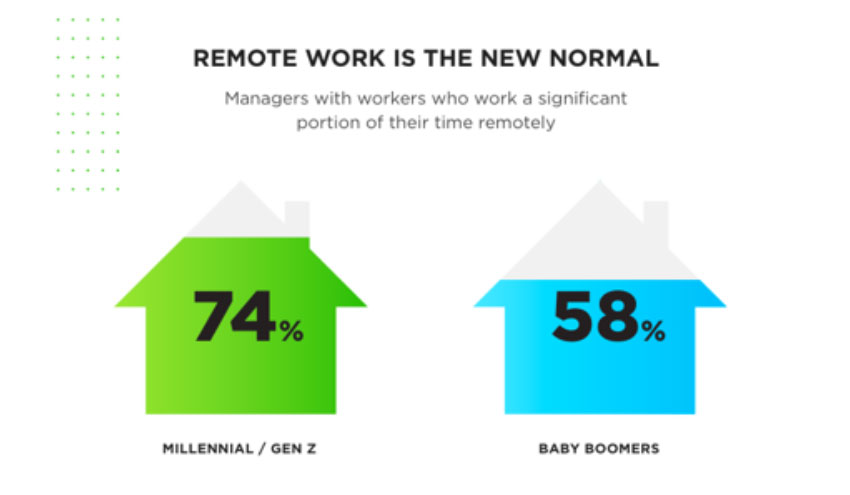
The workplace has undergone some major changes over the last few years – and continues to do so. Office layouts have changed and, as a result of technological innovations, the way we do business, as well as where and when we get work done, has also evolved tremendously. We’re connected digitally and, as a result, are able to work effectively with more distance between a workforce than ever before.
This changing face of business has many organizations asking what the future of work will look like. Many will agree that much of it hinges on how flexible a workforce can be. In fact, we’re already seeing flexible work conditions as one of the most in-demand perks that employees want today.
What is a flexible workforce?
Quite simply, a flexible workforce at any business comprises workers who aren’t bound by a strict nine-to-five routine, five days a week. Employees who form part of a flexible workforce might be working from your office with the freedom to choose their hours, they may be working from home part-time or on a temporary basis, or they may be working from home full-time. In fact, an organization’s entire workforce may have workers dotted across a city or the globe without any physical office space. A flexible workforce could also include part-time or temporary employees, freelancers, or contractors.
Working remotely is becoming the new normal
In a press release detailing the results of the 2019 Future Workforce Report by Upwork, we see that younger generation managers in particular support a remote, flexible workforce as the new norm in business:
- 69% of younger generation managers have employees who are allowed to work remotely.
- Among those that approve remote options, 74% reported having workers who spend a significant portion of their time conducting their jobs remotely, whereas only 58% of Baby Boomers did.
- Younger generation managers are 28% more likely to utilize these flexible options than Baby Boomers and believe that two out of five full-time employees will work remotely within the next three years.
- By 2028, the study projects that 73% of all teams will have people working remotely.

“As younger generations ascend in the workforce and become the majority of managers in corporate America they’ll reshape work as we know it,” said Stephane Kasriel, CEO of Upwork. “We know already that the most in-demand professionals place high value on flexibility.”
Is the flexible workforce really here to stay?
We’ll get to the point quickly by sharing a quote from a recent Forbes article, by Gill Stewart, Managing Director of Capability Jane. It hit the nail on the head:
“I believe we will genuinely stop talking about it; flexible working will just be normal. There will be a home-working space in every home. Co-working, which is already on the rise, will be the norm as big firms as well as small make use of these scalable spaces – and this will not only benefit employees but also allow organizations to keep a cap on real-estate expenditure. The environmental impact will also be front of mind as travel by cars and planes will be frowned upon. When our kids grow up to be future leaders, it will not even cross their minds about when, where, and how they work.”
And, here are a few reasons why it’s a great thing that the flexible workforce is not going anywhere any time soon:
- Establishing a flexible workforce is a great way to attract and retain talent as it offers employers a competitive edge by promoting autonomy.
- It allows employees to be their most productive, as they can choose the hours and/or location that promotes concentration, creativity, and innovation.
- When workers aren’t required to travel into an office, or are able to skip peak traffic, it can save each employee a huge amount of time.
- It gives employers the opportunity to hire employees without geographical limitations, allowing them to bring the best possible talent onto their workforce.
- Similar to the above point, a flexible workforce allows organizations to conduct business across different time zones more easily.
- It’s a great way to promote wellness in the workplace, by making room for work-life balance, which in turn also boosts employee productivity and retention.
Support a flexible workforce
Since a flexible workforce is clearly the way of the future, organizations need to adapt their talent management strategies to be more flexible too. After all, agility is an essential characteristic that they need to take on if they aim to maintain a competitive edge in their business and retain their talent.
Enabling and supporting a modern, flexible workforce will mean introducing the right tools for a cutting-edge approach to HR. As we discussed recently, this is imperative for keeping workers engaged and connected, regardless of their locations. The right HR resources will allow for the following benefits in a flexible workforce:
- Keeping your workforce on the same page and working collaboratively
- Ensuring that communication channels remain open for every employee
- Allowing remote workers the space to be autonomous
- Ensuring that your company culture is inclusive to employees working remotely on a full-time, part-time, or temporary basis (keeping morale high!)
LEARN MORE: Why your employees who are working remotely need better HR tools
Future-proof your business with vi
Prepare your business or organization to establish and support a flexible workforce. Talk to us about our advanced HR software and how it can help you get your talent ready for the future.